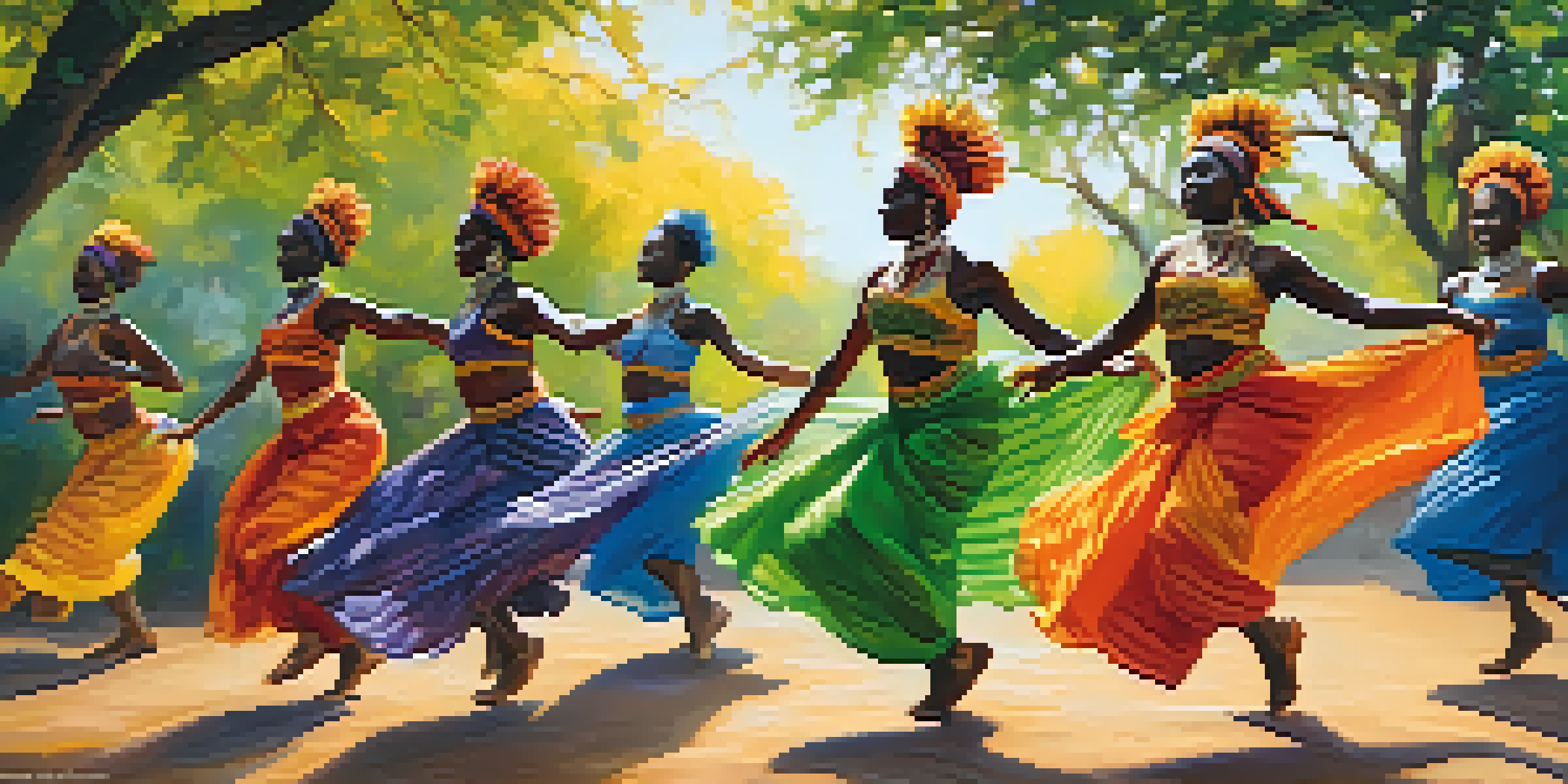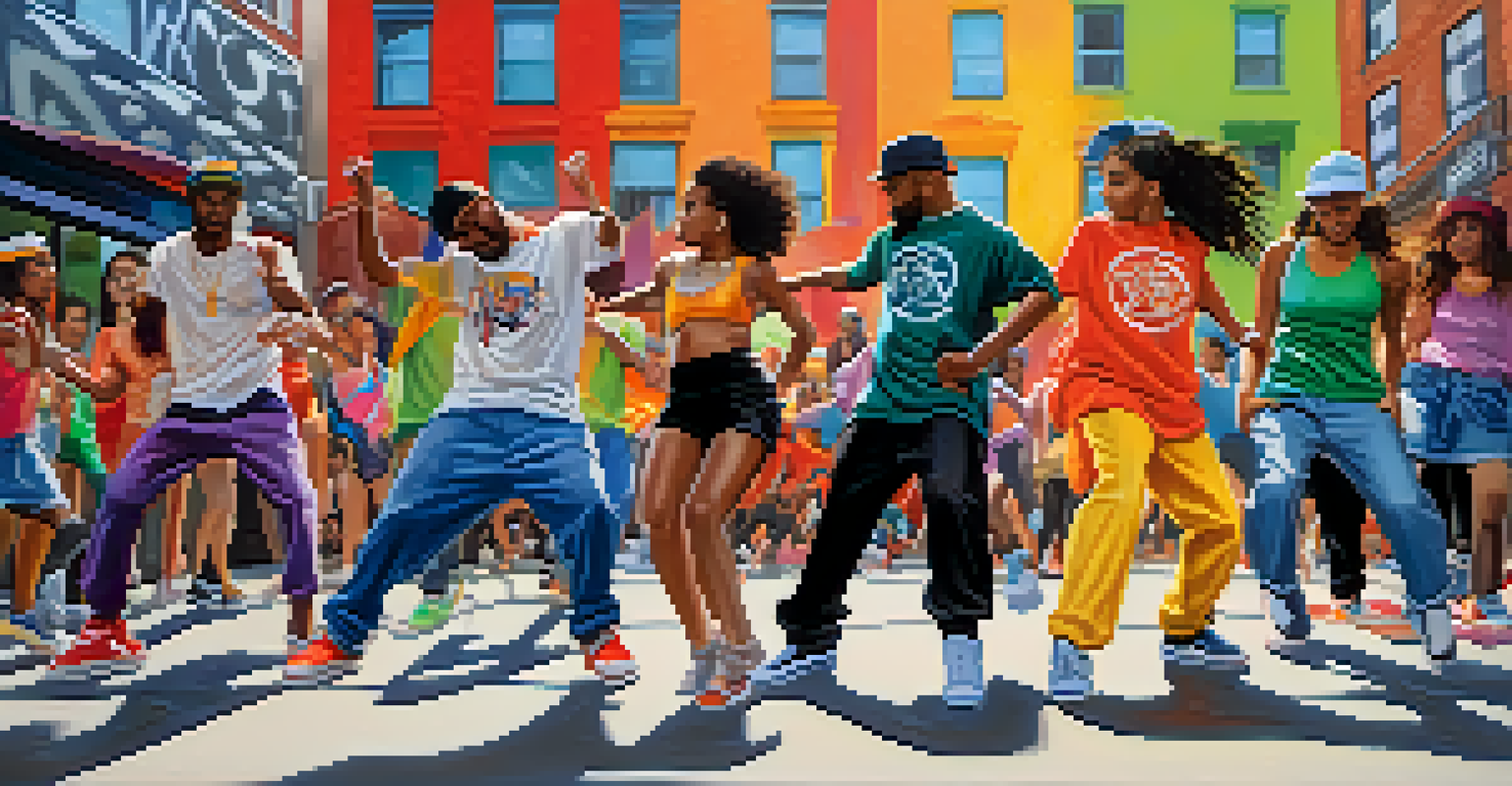The Evolution of Dance Styles and Personal Expression

The Roots of Dance: Cultural Beginnings
Dance has been a part of human culture for centuries, often rooted in rituals and celebrations. From ancient tribal gatherings to royal courts, these early dances were a way for communities to express their beliefs and emotions. They often mirrored the societal values of the time, with movements and styles that reflected the culture’s unique identity.
Dance is the hidden language of the soul.
For example, in African cultures, dance is often used as a form of storytelling, conveying histories and traditions through rhythmic movements. Similarly, the court dances of Europe showcased elegance and poise, reflecting the social hierarchy and norms of the time. These cultural dances set the stage for future evolutions, making them significant in the history of personal expression.
As societies began to evolve, so did their dance styles, moving from communal expressions to more personal interpretations. This shift laid the groundwork for individual creativity within dance, influencing how people would express themselves through movement in the years to come.
The Renaissance: A Flourishing of Dance Forms
The Renaissance period was a vibrant time for arts, including dance. This era saw the birth of ballet, which emphasized structured movements and aesthetics. The introduction of ballet not only refined dance techniques but also provided a new platform for personal expression through choreography.

During this time, dance was often performed in courts and theaters, showcasing the skill and artistry of the dancers. Figures like Catherine de Medici played pivotal roles in promoting dance as an art form, blending it with music and theater for a more holistic experience. This integration allowed dancers to express deeper emotions and narratives through their performances.
Dance Reflects Cultural Identity
Throughout history, dance has served as a vital expression of cultural beliefs and community identity, evolving from communal rituals to personal interpretations.
Moreover, the Renaissance paved the way for the emergence of various regional dance styles, each infused with local flavor. As dance became more accessible, individuals began to explore and adapt these forms, leading to a more diverse expression of personal style and creativity.
The Rise of Folk Dances: Community and Identity
As the world moved into the 18th and 19th centuries, folk dances began to gain popularity. These dances were often tied to specific regions and cultural identities, serving as a means for communities to celebrate their heritage. Think of Irish jigs or Spanish flamenco, where each movement tells a story of its roots.
Dance is the joy of movement and the heart of life.
Folk dances encouraged participation from all community members, not just trained dancers, allowing personal expression to flourish in a communal setting. This accessibility made dance a powerful tool for building identity and solidarity, as people could connect through shared movements and traditions.
The revival of folk dances in modern times reflects a longing for connection to one’s roots. Many people find joy in learning these dances, using them to express their personal and cultural identity while also keeping traditions alive.
The 20th Century: Innovation and Individuality
The 20th century marked a significant turning point in the world of dance. With the emergence of various styles like jazz, hip-hop, and contemporary dance, the focus shifted towards personal expression and innovation. Dancers began to break away from traditional forms, experimenting with new techniques and movements.
For instance, the Harlem Renaissance brought jazz dance to the forefront, reflecting the cultural shifts and social changes of the time. Similarly, the birth of hip-hop in urban environments highlighted individual stories and experiences, allowing dancers to express their unique perspectives through movement.
Innovation in Dance Styles
The 20th century brought significant innovation in dance, with new styles emerging that emphasized individual creativity and personal expression.
This era also saw the rise of dance as a popular entertainment form, with television shows and movies showcasing diverse styles. As dance became more mainstream, it opened doors for individuals to explore and share their own expressions, leading to a rich tapestry of dance styles that continue to evolve today.
Dance as a Form of Activism and Expression
In recent decades, dance has emerged as a powerful form of activism and social commentary. Choreographers and dancers have utilized their art to address pressing social issues, creating movements that resonate on a personal and collective level. Dance provides a unique platform to express dissent, solidarity, and hope.
For example, the Black Lives Matter movement saw dancers using their bodies to advocate for justice and equality, transforming protests into powerful performances. Similarly, LGBTQ+ communities have harnessed dance as a means to celebrate identity and challenge societal norms, often using drag performances to blend art and activism.
This intersection of dance and activism highlights its role as a significant medium for personal expression, allowing individuals to voice their stories and experiences. As dance continues to evolve, its potential to inspire change and foster connection remains strong.
The Digital Age: Dance in the Era of Technology
The rise of social media and technology has transformed how dance is created, shared, and experienced. Platforms like TikTok and Instagram have given rise to viral dance trends, allowing individuals to express themselves creatively on a global scale. This democratization of dance has enabled anyone to participate, regardless of skill level.
Moreover, technology has expanded the ways in which dance can be taught and learned. Online tutorials and virtual classes have made it easier for people to explore different styles from the comfort of their homes, fostering a sense of community among dancers worldwide. This accessibility encourages personal expression, as individuals can experiment with various styles and find their unique voice.
Dance as Activism and Connection
In recent years, dance has become a powerful medium for activism, allowing individuals to express social issues and foster connections within communities.
The digital age has not only changed how we view dance but also how we connect with it. With the ability to share performances instantly, dancers can showcase their individuality and creativity, leading to an ever-evolving landscape of dance that reflects personal stories and cultural shifts.
The Future of Dance: Personal Expression and Beyond
As we look to the future, dance will likely continue to evolve in exciting ways. With the ongoing blending of styles and influences, personal expression will remain at the forefront of dance culture. Dancers will continue to draw inspiration from diverse sources, creating innovative movements that reflect their unique experiences.
The integration of technology will also play a significant role in shaping the future of dance. With advancements in virtual reality and augmented reality, we may see new ways to experience and interact with dance, allowing for immersive performances that push the boundaries of traditional expression.

Ultimately, dance will always be a reflection of the human experience, adapting to the times while remaining a vital form of personal expression. As individuals continue to share their stories through movement, the dance community will thrive, celebrating diversity and creativity for generations to come.